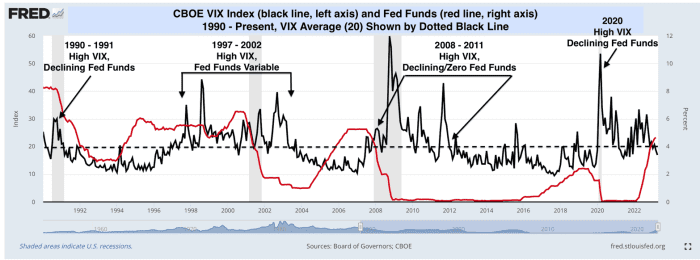This post was originally published on this site
Investors once again penciling in a pivot to rate cuts by the Federal Reserve aren’t getting any backup from a closely watched gauge of expected stock-market volatility, one Wall Street analyst warned Wednesday.
The Cboe Volatility Index
VIX,
commonly referred to by its ticker symbol, “VIX,” closed Tuesday at 16.83, its lowest finish since Jan. 3, 2022, according to Dow Jones Market Data. The options-based index measures expectations for S&P 500
SPX,
volatility over the next 30 days. It remains well below its long-term average of around 20.
The rub right now is that the rates market shows that traders see a 93% probability the Fed will cut rates later this year after one more hike in May (which is seen as a roughly 86% probability). But history shows that the Fed tends to cut interest rates only when stock-market volatility rises quickly as a result of either a geopolitical shock or a clearly imminent recession, said Nicholas Colas, co-founder of DataTrek Research, in a Wednesday note (see chart below).

DataTrek Research, Federal Reserve Bank of St. Louis
“As far as we’re concerned, this is the real ‘Fed put,’” Colas said.
The proverbial Fed put is the notion that the monetary-policy makers will cut rates and run to the rescue when the stock market tumbles. In real life, a put option is an instrument that gives the holder the right but not the obligation to sell an underlying asset at a set price by a certain date — a valuable hedge if the price of the asset goes south.
So far the VIX isn’t offering any signs the Fed put is likely to be exercised. The Fed has often, but not always, cut rates when the VIX has spiked, Colas recalled, including right after the 1990 Iraqi invasion of Kuwait, during the 1998 Asia Crisis, heading into the 2002 and 2008 recessions, and at the start of the pandemic in 2020.
There are exceptions. Elevated volatility near the peak of the 1990s dot-com bubble came with a higher, rather than lower, fed-funds rate. Last year’s rise in the VIX was another case, with Fed Chair Jerome Powell and Fed policy makers embracing stock-market volatility as they pursued a reduction in consumption and investment, he wrote.
Falling volatility expectations come as stocks have seen directionless trade at the start of first-quarter earnings season, though indexes remain near their highs of the year. The S&P 500, Dow Jones Industrial Average
DJIA,
and Nasdaq Composite
COMP,
all moved less than 0.1% on Tuesday — the first time all three indexes saw a change of less than one-tenth of a percentage point on the same trading day since Nov. 15, 2021, according to Dow Jones Market Data.
See: Why bears can’t keep the stock market down despite bad news
With the VIX below 17 and marking a fresh low this week, “the market is very far from telling the Fed they need to reduce short-term interest rates,” Colas said. “Between now and those expected rate cuts later this year we will, therefore, need to see the sort of volatility that pushes the Fed to act. Otherwise, why would the Fed do anything other than keep rates where they are?”
Check out: U.K. inflation shock sparks fear U.S. markets will get caught off guard again

